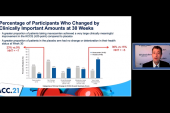Aficamten Safe, Effective for Up to 6 Months in Obstructive HCM: REDWOOD-HCM OLE
The findings, from an extension study, are reassuring as a larger phase III trial continues enrolling, researchers say.

Aficamten (Cytokinetics), a novel cardiac myosin inhibitor, safely reduces left ventricular outflow tract (LVOT) gradients and relieves heart failure symptoms in patients with obstructive hypertrophic cardiomyopathy (HCM), results of the REDWOOD-HCM Open Label Extension study suggest.
Reductions in both resting and Valsalva LVOT gradients were seen within 2 weeks of treatment initiation, with continued improvements through up to 24 weeks of follow-up, Ahmad Masri, MD (OHSU Center for Hypertrophic Cardiomyopathy and Amyloidosis, Portland, OR), reported recently at the European Society of Cardiology Heart Failure (ESC-HF) 2022 congress in Madrid, Spain.
Most patients (78%) improved by at least one NYHA class over that span, during which levels of NT-proBNP and cardiac troponin I dropped (by 70% and 20%, respectively).
The drug was well tolerated, with no cases of LVEF falling below 50% that were directly connected with treatment, Masri said.
The findings are consistent with the phase II REDWOOD-HCM trial, but the data from the extension study stretch follow-up from 10 to 24 weeks. “Patients are doing well on aficamten and there were no unexpected adverse events,” Masri told TCTMD.
That additional information is important and reassuring, he said, because investigators are actively enrolling patients into the phase III SEQUOIA-HCM trial, which will be the largest obstructive HCM trial to date (estimated enrollment of 270 patients) and will follow participants for 24 weeks on aficamten treatment and another 4 weeks off treatment.
Tailored Therapy for Obstructive HCM
Historically, Masri said, the pathophysiology of HCM has not been well understood. Some therapies have shown some benefit in this condition—such as beta-blockers, calcium channel blockers, and disopyramide—but their effects are not that strong, particularly in patients with severe disease. Anatomical modification using surgery or alcohol septal ablation works well for patients with LVOT obstruction, but these procedures are performed at highly specialized centers and are not available for most patients around the world.
Importantly, these treatments don’t directly address the underlying disease process in obstructive cardiomyopathy, Masri stressed.
Aficamten is part of a new class of agents specifically designed to treat obstructive HCM, the cardiac myosin inhibitors. Last month, mavacamten (Camzyos; Bristol Myers Squibb) became the first of these agents to receive US Food and Drug Administration approval. Both aficamten and mavacamten ease the hypercontractility of obstructive HCM and improve diastolic function, but they inhibit cardiac myosin by binding to different sites, Masri explained.
Moreover, aficamten has a shorter half-life, reaching steady state within 2 weeks versus 4 to 6 weeks for mavacamten. “This quick onset helps you with severe symptoms but also, more importantly, if a problem happens, it helps you with withdrawal of the drug itself,” Masri said. He added that mavacamten is extensively metabolized in the liver, increasing drug-drug interactions, an issue that doesn’t apply to aficamten.
REDWOOD-HCM OLE Study
The phase II REDWOOD-HCM trial included three cohorts of patients with obstructive HCM who received aficamten doses ranging from 5 to 30 mg. Two of the cohorts included a placebo control, and one included patients also treated with disopyramide. All of those patients were invited to join the REDWOOD-HCM Open Label Extension study, which will follow participants for up to 5 years.
Masri presented interim results on the first 38 patients (mean age 59.9; 57.9% women) to enroll, all of whom had both resting and provoked LVOT obstruction. They were roughly evenly split between NYHA class III (52.6%) and class II (47.4%). Mean LVEF at screening was 69.7%.
Doses were titrated based on echocardiographic guidance. This analysis included patients treated with doses ranging from 5 to 15 mg, although the 20-mg dose has since been made available to study participants.
In terms of background therapy, 78.9% of patients were taking a beta-blocker, 28.9% a calcium channel blocker, and 26.3% disopyramide.
Within 2 weeks of treatment initiation, resting and Valsalva LVOT gradients declined significantly, with those improvements sustained through 24 weeks (P ≤ 0.001 for each time point).
All patients had NYHA class II or III symptoms at baseline, and by week 24, only 6% had class III symptoms, 39% class II, and 56% class I. Most patients (61%) improved by one class, and 17% improved by two classes. No patients worsened.
The reductions in cardiac biomarkers were significant, Masri said, explaining that NT-proBNP is a measure of wall stress in HCM that tracks with outcomes and how patients feel. The fall in troponin, he added, indicates a reduction in subclinical myocardial injury.
In terms of safety, the main concern is that inhibition of cardiac myosin and a subsequent reduction in myocardial contractility could result in a large drop in LVEF, but that wasn’t seen here. There was a “gentle”—though significant—reduction in LVEF through 24 weeks, Masri reported. Eight patients (21%) had a related treatment-emergent adverse event, but none had a reduction in LVEF to below 50% that was attributed directly to aficamten. In one patient taking aficamten, LVEF dropped to 47%, but it was deemed related to a recurrent episode of alcohol-induced atrial fibrillation; the drug was temporarily discontinued but then restarted. The most common adverse events were headache in four patients and dizziness in three.
Overall, Masri said, “these are great results. Aficamten’s efficacy is durable for out to 6 months, and it is safe with no unexpected adverse events.”
‘Future is Bright’
Commenting for TCTMD, Milind Desai, MD, MBA (Cleveland Clinic, OH), who recently reported the results of the VALOR-HCM trial, showing that mavacamten reduces the need for surgical or interventional septal reduction therapy in patients with obstructive HCM, said these new results demonstrate that aficamten is well tolerated and improves LVOT gradients and NYHA class, similar to what’s been seen in prior studies.
Though there was not a big drop in LVEF in any aficamten-treated patients, and no drug-drug interactions have been observed thus far, it will be important to track both issues in larger, longer-term studies, Desai said.
“This is a class of medications that by design will reduce contractility of the heart muscle and in a small proportion of cases it may go overboard, so our job as physicians or caregivers is to make sure we develop tools . . . where we can predict who will potentially drop their ejection fraction versus not,” he said. “Until we do that, then we [have to be] diligent about monitoring the ejection fraction and reacting if the EF drops.”
As long as no unexpected safety issues arise in upcoming trials, aficamten “will be an important addition in the armamentarium of treatment of these patients,” Desai said about the outlook for the drug. “Choice is always good.”
Taking a broader view, he added that “this class of precision drugs developed specifically to work on obstructive HCM patients may serve as an important alternative to patients who may or may not want septal reduction therapy or invasive surgeries. . . . The field is rapidly evolving and the future is bright.”
If aficamten is ultimately approved, Masri said, any patient with obstructive HCM and symptoms could be a candidate for treatment. “I do see that aficamten, as well as mavacamten, would become essentially a second-line agent after beta-blockers and calcium channel blockers.”
Todd Neale is the Associate News Editor for TCTMD and a Senior Medical Journalist. He got his start in journalism at …
Read Full BioSources
Masri A. Efficacy and safety of aficamten in patients with symptomatic obstructive hypertrophic cardiomyopathy. Presented at: ESC-HF 2022. May 23, 2022. Madrid, Spain.
Disclosures
- Masri reports research grants from Pfizer, Akcea, Ionis, and Ultromics; fees from Eidos, Pfizer, Ionis, BMS, Attralus, Tenaya, Alnylam, and Cytokinetics; and research funding for clinical trial activities from Myokardia/BMS, Pfizer, Cytokinetics, Ionis, Akcea, Eidos, Imbria, Prothena, Alnylam, and Novartis.
- Desai reports being an investigator in the SEQUOIA-HCM trial.





Comments